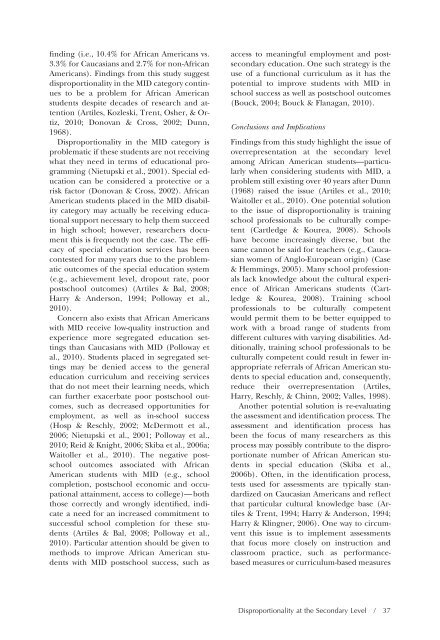etadd_48(1) - Division on Autism and Developmental Disabilities
etadd_48(1) - Division on Autism and Developmental Disabilities
etadd_48(1) - Division on Autism and Developmental Disabilities
Create successful ePaper yourself
Turn your PDF publications into a flip-book with our unique Google optimized e-Paper software.
finding (i.e., 10.4% for African Americans vs.<br />
3.3% for Caucasians <strong>and</strong> 2.7% for n<strong>on</strong>-African<br />
Americans). Findings from this study suggest<br />
disproporti<strong>on</strong>ality in the MID category c<strong>on</strong>tinues<br />
to be a problem for African American<br />
students despite decades of research <strong>and</strong> attenti<strong>on</strong><br />
(Artiles, Kozleski, Trent, Osher, & Ortiz,<br />
2010; D<strong>on</strong>ovan & Cross, 2002; Dunn,<br />
1968).<br />
Disproporti<strong>on</strong>ality in the MID category is<br />
problematic if these students are not receiving<br />
what they need in terms of educati<strong>on</strong>al programming<br />
(Nietupski et al., 2001). Special educati<strong>on</strong><br />
can be c<strong>on</strong>sidered a protective or a<br />
risk factor (D<strong>on</strong>ovan & Cross, 2002). African<br />
American students placed in the MID disability<br />
category may actually be receiving educati<strong>on</strong>al<br />
support necessary to help them succeed<br />
in high school; however, researchers document<br />
this is frequently not the case. The efficacy<br />
of special educati<strong>on</strong> services has been<br />
c<strong>on</strong>tested for many years due to the problematic<br />
outcomes of the special educati<strong>on</strong> system<br />
(e.g., achievement level, dropout rate, poor<br />
postschool outcomes) (Artiles & Bal, 2008;<br />
Harry & Anders<strong>on</strong>, 1994; Polloway et al.,<br />
2010).<br />
C<strong>on</strong>cern also exists that African Americans<br />
with MID receive low-quality instructi<strong>on</strong> <strong>and</strong><br />
experience more segregated educati<strong>on</strong> settings<br />
than Caucasians with MID (Polloway et<br />
al., 2010). Students placed in segregated settings<br />
may be denied access to the general<br />
educati<strong>on</strong> curriculum <strong>and</strong> receiving services<br />
that do not meet their learning needs, which<br />
can further exacerbate poor postschool outcomes,<br />
such as decreased opportunities for<br />
employment, as well as in-school success<br />
(Hosp & Reschly, 2002; McDermott et al.,<br />
2006; Nietupski et al., 2001; Polloway et al.,<br />
2010; Reid & Knight, 2006; Skiba et al., 2006a;<br />
Waitoller et al., 2010). The negative postschool<br />
outcomes associated with African<br />
American students with MID (e.g., school<br />
completi<strong>on</strong>, postschool ec<strong>on</strong>omic <strong>and</strong> occupati<strong>on</strong>al<br />
attainment, access to college)—both<br />
those correctly <strong>and</strong> wr<strong>on</strong>gly identified, indicate<br />
a need for an increased commitment to<br />
successful school completi<strong>on</strong> for these students<br />
(Artiles & Bal, 2008; Polloway et al.,<br />
2010). Particular attenti<strong>on</strong> should be given to<br />
methods to improve African American students<br />
with MID postschool success, such as<br />
access to meaningful employment <strong>and</strong> postsec<strong>on</strong>dary<br />
educati<strong>on</strong>. One such strategy is the<br />
use of a functi<strong>on</strong>al curriculum as it has the<br />
potential to improve students with MID in<br />
school success as well as postschool outcomes<br />
(Bouck, 2004; Bouck & Flanagan, 2010).<br />
C<strong>on</strong>clusi<strong>on</strong>s <strong>and</strong> Implicati<strong>on</strong>s<br />
Findings from this study highlight the issue of<br />
overrepresentati<strong>on</strong> at the sec<strong>on</strong>dary level<br />
am<strong>on</strong>g African American students—particularly<br />
when c<strong>on</strong>sidering students with MID, a<br />
problem still existing over 40 years after Dunn<br />
(1968) raised the issue (Artiles et al., 2010;<br />
Waitoller et al., 2010). One potential soluti<strong>on</strong><br />
to the issue of disproporti<strong>on</strong>ality is training<br />
school professi<strong>on</strong>als to be culturally competent<br />
(Cartledge & Kourea, 2008). Schools<br />
have become increasingly diverse, but the<br />
same cannot be said for teachers (e.g., Caucasian<br />
women of Anglo-European origin) (Case<br />
& Hemmings, 2005). Many school professi<strong>on</strong>als<br />
lack knowledge about the cultural experience<br />
of African Americans students (Cartledge<br />
& Kourea, 2008). Training school<br />
professi<strong>on</strong>als to be culturally competent<br />
would permit them to be better equipped to<br />
work with a broad range of students from<br />
different cultures with varying disabilities. Additi<strong>on</strong>ally,<br />
training school professi<strong>on</strong>als to be<br />
culturally competent could result in fewer inappropriate<br />
referrals of African American students<br />
to special educati<strong>on</strong> <strong>and</strong>, c<strong>on</strong>sequently,<br />
reduce their overrepresentati<strong>on</strong> (Artiles,<br />
Harry, Reschly, & Chinn, 2002; Valles, 1998).<br />
Another potential soluti<strong>on</strong> is re-evaluating<br />
the assessment <strong>and</strong> identificati<strong>on</strong> process. The<br />
assessment <strong>and</strong> identificati<strong>on</strong> process has<br />
been the focus of many researchers as this<br />
process may possibly c<strong>on</strong>tribute to the disproporti<strong>on</strong>ate<br />
number of African American students<br />
in special educati<strong>on</strong> (Skiba et al.,<br />
2006b). Often, in the identificati<strong>on</strong> process,<br />
tests used for assessments are typically st<strong>and</strong>ardized<br />
<strong>on</strong> Caucasian Americans <strong>and</strong> reflect<br />
that particular cultural knowledge base (Artiles<br />
& Trent, 1994; Harry & Anders<strong>on</strong>, 1994;<br />
Harry & Klingner, 2006). One way to circumvent<br />
this issue is to implement assessments<br />
that focus more closely <strong>on</strong> instructi<strong>on</strong> <strong>and</strong><br />
classroom practice, such as performancebased<br />
measures or curriculum-based measures<br />
Disproporti<strong>on</strong>ality at the Sec<strong>on</strong>dary Level / 37
















